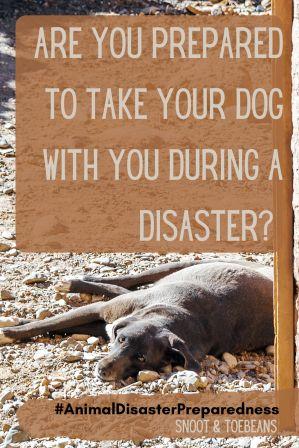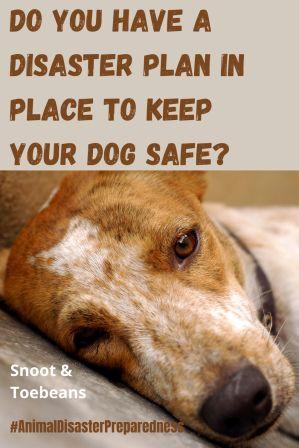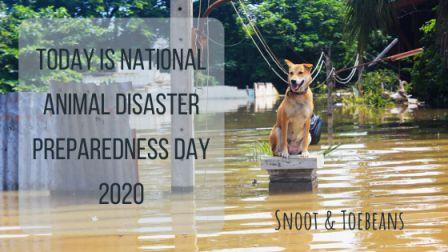Disclosure: My dog blog is supported by dog parents just like you. I only recommend products that I would use on my dogs. All opinions expressed here are my own. I sometimes earn a small affiliate commission, at no extra cost to you, when you click through the affiliate link and purchase something. You can read more about my affiliate policy here.
Are you prepared for a disaster or an emergency? Do you have a plan in place to keep your pets safe? Begin today, equipping yourself with the knowledge and tools needed to keep your pets safe if disaster strikes. Today is National Animal Disaster Preparedness Day.
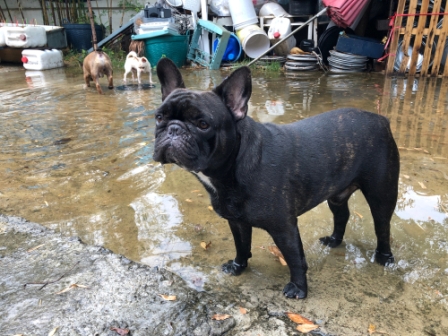
In fact, National Animal Disaster Preparedness Day is observed every year on the second Saturday in May. As a result, this day is designed around the importance of planning for the safety of pets. Most importantly, planning before a disaster or emergency arises.
Animal disaster preparedness became an important issue in 2005 after Hurricane Katrina. For instance, it’s estimated that over 15,500 pets were ultimately rescued. According to the Louisiana SPCA, the exact number of animals that died is unknown. However, it’s estimated to be in the tens of thousands.
Most importantly, of the 15,500 pets rescued, only 15% to 20% were ever reunited with their families. Bottom line, these pets were left behind, because their families did not not include them in their evacuation. Therefore, National Animal Disaster Preparedness Day was established to educate on the importance of including pets in preparation.
“Preparedness is peace of mind, and including our animals in preparedness plans before an emergency or disaster is the best way to ensure the safety of people and their pets.”
Dr. Heather Case, Chief Executive Officer at International Council for Veterinary Assessment
Animal Disaster Preparedness – 3 Tips
Disasters and emergencies can affect animals just like people, whether big or small, natural or man-made. Furthermore, disasters can look natural like a hurricane or tornado, a flood or earthquake, or a snow storm. On the other hand, they can look man-made like a chemical leak or an act of terrorism.
Preparing now by creating an emergency plan will help you better maneuver through such an event. For instance, you will likely encounter less difficulty, stress, and worry.
It is important to understand that your pets will be even more dependent on you during an emergency. For example, they will rely on you for their safety and well-being.
You must include your fur babies in your disaster plan in order to avoid what happened during Katrina. Your four-legged family members should be just as important as your two-legged family members.
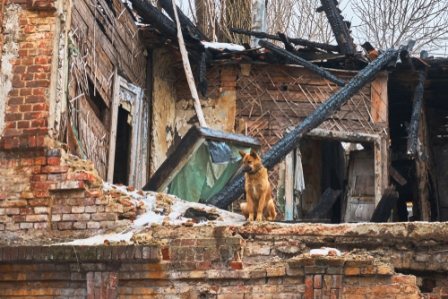
So, since our pets are family, let’s be conscious of including them in our emergency plans. Following are three tips to help you prepare for a disaster or emergency in advance.
1) Be Aware
Although you can’t predict every dangerous situation, you can learn the most likely dangers for your geographical area. For example, your specific area may be susceptible to earthquakes, hurricanes, tornadoes, flooding, etc. Furthermore, discover what your local evacuation plans and routes are, along with knowing when to shelter in place.
2) Design an Evacuation Plan
In the event, you need to evacuate your home, then your pet goes with you. Because, I promise if it’s not safe for you to stay there, it surely isn’t safe for them.
So, it’s important to have a plan in place in the event of evacuation. That is to say, many places will not accept animal guests. For example, many hotels do not, other than service animals.
In addition, many shelters including the Red Cross, do not allow pets due to health and safety concerns. Of course with the exception of service animals.
Therefore, you need to plan in advance for shelter alternatives. For instance, look for pet friendly hotels and homes of out of town relatives or friends. In addition, these need to be on your evacuation route.
Prepare a list with phone numbers of possible friends, relatives, shelters or veterinarians who can help during evacuation. Furthermore, consider a back up plan in case you are not at home when a disaster takes place.
Part of a back up plan can be keeping a rescue alert sticker on a window or door. Consequently, this will alert rescuers that pets live in the home. However, if you evacuate with your pets, as a part of your plan, write “evacuated” on the sticker.
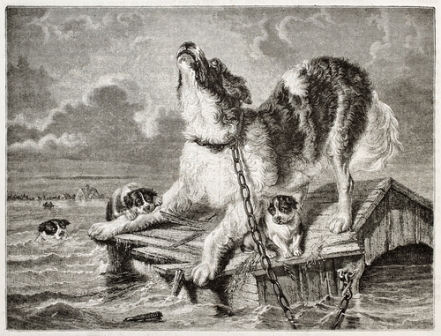
Furthermore, if you are home, do everything in your power to take your pets with you when evacuating. They will not be able to fend for themselves in a disaster situation. Absolutely, under no circumstances should you evacuate, knowingly leaving your pet chained in the yard. Similarly, do not leave them trapped in cages or carriers.
3) Animal Preparation That Includes an Emergency Kit
Firstly, make sure that your pets have current vaccinations. Secondly, make sure that cats and dogs are wearing collars with up-to-date identification. Thirdly, consider having your pet “microchipped” now, before a disaster or emergency happens.
You can make or purchase an animal emergency kit. If you decide to make one, be sure to seek advice from your veterinarian. They will be able to help you on what to include to meet your pet’s individual needs.
In general you can include the following items in an animal emergency kit:
- Water – store 7 to 10 days of water per pet in easy to transport containers; rotate every two months
- Food – keep 7 to 10 days of food in an airtight, waterproof container; rotate every two months; manual can opener for canned food
- Medicines
- Medical and vaccine records sealed in a plastic bag
- First aid supplies such as, cotton bandage rolls, bandage tape, scissors, antibiotic ointment, latex gloves, rubbing alcohol, and saline solution; read more on the essentials of first aid for dogs
- Collar with ID tag
- Harness and leash
- Rabies tag
- Sanitation supplies such as, pet litter and litter box, potty pads, paper towels, plastic trash bags, household chlorine bleach (not scented or color safe)
- Photo of you and your pets together for in the event you become separated, you can prove ownership
- Crate or other pet carrier – large enough for your pet to stand, turn around and lie down
- Blankets and towels to use as bedding and for warmth
- Toys
- Beds
- Information on feeding schedules, medical conditions, behavior problems, and the name and number of your veterinarian in the event you must foster or board your pets
Keep your animal emergency kit/supplies in an accessible place. In addition, store them in sturdy containers so that they can be carried easily.
Animal Disaster Preparedness Resources
- The AVMA’s Saving the Whole Family brochure offers a comprehensive list of how to safeguard pets. This includes before, during and after a disaster. In addition, it is also available in Spanish, Salvando a la Familia Entera.
- The ASPCA recommends using a rescue sticker alert » to help emergency workers find your pets. This sticker also lets neighbors and volunteers know that pets are inside your home. Furthermore, the information should include the types and number of pets along with your veterinarian’s phone number. In the event that you evacuate with your pets, write “evacuated” on the sticker. To clarify, this notifies rescue workers to not waste time looking for them.
- Get critical first aid information with the Pet First Aid App by the American Red Cross. Find it in the Apple App Store », Google Play », or Amazon Marketplace »
- Download this Pets and Disaster Safety Checklist from the American Red Cross.
In Summary
I know the thought of a disaster or emergency is stressful, but being prepared can save lives. So today on National Animal Disaster Preparedness Day, plan ahead.
Therefore, you will keep your family and your pets safe in case you are faced with a disaster. Most importantly, never leave your pets behind.
Do you have some more tips that you could add to ours? We would love to read about them in the comments below.
Have you experienced a disaster or emergency with your pets? Tell us about your experience in the comments below.
Speaking of putting a plan in place, you might like this post, on dog separation anxiety.
If you want to save this post, you can pin one of the following images to Pinterest.
